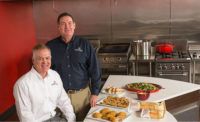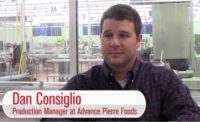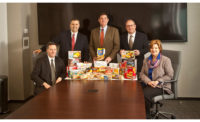Part of the selling point for AdvancePierre Foods (APF) to potential investors leading up to the company’s initial public offering (IPO) last year was the claim that APF was a veritable expert on acquiring smaller companies, integrating them quickly and maximizing synergies to grow the business, having done so frequently in recent years.
In the fall of 2016, APF made its first acquisition as a public company (Philly-steak processor Allied Specialty Foods of Vineland, N.J.), and one can expect investors to watch that integration closely. However, two major acquisitions from 2015 (Landshire and Better Bakery) were pranced in front of pre-IPO investors as prime evidence of the company’s capability as an acquirer.
In conjunction with this month’s cover story, I toured the sandwich-assembly plant in Caseyville, Ill., which APF acquired in January 2015, and sat down with COO George Chappelle and Dan Consiglio, production manager in Caseyville, to discuss the plant’s progress in becoming a tried-and-true APF facility. What follows is part of our conversation:
Hanacek: It has been a bit of a whirlwind ride for not only AdvancePierre Foods, but also for the employees at this former Landshire plant. Can you explain how APF ended up purchasing and integrating the Caseyville plant over the last two-plus years?
Chappelle: In the middle of 2014, the company decided we need to acquire some assets in the sandwich area, both in terms of the bakery and assembly side, to enhance our ability to compete in the market. We were already one of the biggest frozen sandwich makers in the country, but we wanted to further accentuate that capability. We started to negotiate an acquisition with Landshire, a St. Louis-based company owned by the Trover family. In January 2015, we bought the plant and part of the business that serves the retail and convenience channels predominantly.
At the time, we were also negotiating purchase of a business on the West Coast called Better Bakery. Better Bakery was significant to us because it was a premium sandwich, with a very clean label and higher-end sell price. Secondarily, it had a relationship with Cinnabon to make Gooey Bites, the bowl-based small dough frosted business. We bought that business, but knew we did not want the plant on the West Coast. In Caseyville, we knew we had some expansion capability, so we built the Better Bakery business into this plant.
Hanacek: What was the rough time frame to incorporate and institute all those things then?
Chappelle: One of the things we pride ourselves on is being able to bolt on smaller business relatively quickly and seamlessly. In the first 90 days, we had this plant on our ERP system. Then we implemented our APF Way system, by which we measure just about everything. We scorecard everything. That takes a little longer culturally, and I think when people understand why we do it, they get it, but it is very intense. In my experience working in this business for more 30 years, APF is probably the most intense, numerically scorecard-driven company I’ve ever been with.
But the other side of it is, we’re a fairly generous company when it comes to benefits. So, particularly in this acquisition and the one we most recently did [Allied], one of the things people realize is our benefits system is very good. Our compensation system is above market versus some of the smaller family-owned companies, and we don’t look to change that.
Hanacek: You mentioned that when the company acquired Better Bakery, APF knew it didn’t want the West Coast plant. How did the Better Bakery operation fit in here at Caseyville?
Chappelle: We rebuilt the lines here and this operation, to the employees’ credit, has taken it on. It’s a very artisan-style product compared to what we normally produce. Other than getting the material to the line, our sandwich-assembly process is very standardized. However, Better Bakery and our Cinnabon Gooey Bites are processed much differently, through an artisan, more hand-made process, just like the product packaging says. But that’s why we bought it. It’s an upscale sandwich and product, and we felt as though we needed to round out the portfolio in that area.
Hanacek: So when was the Better Bakery line fully operational?
Chappelle: I believe the line ramped up July 1, 2015. It was a significant, multimillion-dollar investment, [and nearly] everything there is brand new. We built it up very quickly, ramped up the business and didn’t lose a beat in terms of satisfying customer orders or otherwise.
Hanacek: Have there been any facility expansions or additions made in Caseyville since you acquired it?
Chappelle: No, but we will expand at some point. We own the cornfields south and west, and a little bit north. It’s about 25-30 acres. One of the attractive parts of buying Caseyville, quite frankly, was the land. We’re landlocked almost everywhere else — this land is one of the green-field areas where we can play. The question is what product set will go in [that future expansion]. We’re trying to be analytical on how we use it. Then you look at our recent Allied acquisition and the facility that is being built and will be ready [around the New Year]. There’s about 50,000 square feet of space there. For the first time, we have the luxury of theorizing on what we might do, when usually we’re trying to figure out how we can fit stuff into existing footprint.
Hanacek: What makes the Caseyville facility particularly unique, versus it being just a typical sandwich-processing facility owned by AdvancePierre Foods?
Chappelle: This is a little bit of a gem, to be honest, because it’s very unusual to have a bakery integrated with a sandwich-assembly facility. [When you can] bake the bread in the facility and take it right to the line, that’s a huge benefit. There’s less waste, as well as a significant cost advantage, just in transportation. … You’ve got to bake it, rack it, roll it onto a truck, transport it, unload it, unrack it, etc., and bread is essentially a living organism that goes stale. Lastly, it’s fragile, it breaks and it crumbles. So whenever you can eliminate the handling and get the benefit of having a better quality product by having it right here, and then combine it with the fact that we make the protein that goes into the sandwich in 60 percent of the cases as well, the capability you have is huge.
Hanacek: What additional considerations do you have to take into account by having the bakery onsite? Additionally, what differences are there to running the Caseyville plant versus the other APF plants?
Chappelle: I’m not a bread scientist, but one of the things you have to consider is just the flow of product. You have a lot more movement than a normal sandwich assembly plant. So that’s a consideration.
Video Q&A: Dan Consiglio, production manager at APF, discusses how the company has driven success at the Caseyville, Ill. plant.Consiglio: The product mix here is a lot more diverse than at the Amherst and Claremont plants. Claremont is like a frozen puck-style manufacturer, where Amherst is maybe a little mix of sliced meat, but a lot more frozen patties. Here in Caseyville, we do a mixture of both, but our business is more sliced meat, which has its own challenges.
Hanacek: Dan, you’ve been here in Caseyville for a little more than a year now — what has stood out for you in terms of the workforce, in terms of the production itself?
Consiglio: I’ve had the luxury of working for both regimes here. We started off learning everything from scratch. I didn’t [learn] the Landshire way, though, because I started with APF, so the only thing I knew was APF. Soon after I started, we had a management change, so I’ve had the luxury of seeing two different sides of this coin here.
So, I can see the huge transition in culture, style and things that maybe we weren’t necessarily successful with before that we’re more successful with now. Looking at the [performance] board up there, we’re seeing more green than I have ever seen. Last week our performance was the best we’ve ever had in a 5-day window. We’ve made some major strides and are hitting, and then exceeding, what we need to hit in some areas.
The big change has been culture, management style and putting in the processes and metrics, and making sure we’re driving them home and doing what we say we’re supposed to be doing. The other part is really the top-down leadership getting everybody engaged, on the same page, rowing in the same direction.
We look at Caseyville as three mini plants in one: Better Bakery, RTE, and the old bakery. We break out our KPIs [by those divisions], and we average them together to be judged. In the scorecard, it’s broken out too, so we can work on certain aspects and avenues, and make sure we’re successful.
Hanacek: You hinted at the future, you’ve got the land around here, you can be selective as to what types of production you bring here. Obviously there will be sandwich-based production here, but do you see this place being able to do some of the product that maybe your Enid facility does, or would that be too much of a stretch to add on those types of production?
Chappelle: I don’t see this being a protein cook facility, and the fact that it’s integrated on the bakery side is really what we will try to [maximize]. On the protein side, the transportation issues I mentioned on bread [are smaller]. You can put 40,000 pounds of any type of protein on a truck and transport it pretty easily.
That said, I do see this plant eventually being able to do other things. We’re trying to work through that now. But they’re all more in sandwich format capability and maybe bakery capability. We’re not trying to turn it into a protein facility. When you see the Better Bakery part of production, you see what the plant is capable of producing.
Hanacek: How does Caseyville fit in terms of the grand scheme of APF moving forward? The executive team talked about being more of a sandwich company, a food-based company.
Chappelle: Starting at the very macro level, we’ve told our investors, both pre-IPO and post-IPO, that we are going to acquire companies. We pointed to a few companies we’ve acquired; one was Barber back in 2011. We talked about purchase price, post-synergy multiples, etc. … I would point to Landshire, No. 1, as a very good example of what we can do when we put our capital to work and put our mindset to work in terms of how we operate as APF. This plant has expanded dramatically and is supporting about 30 percent more sales than when we bought it.
If you just look at our scale and our ability to sell and distribute product, it far exceeds your small regional suppliers. So when we find companies like this a light immediately goes on about what we can do with it. Also, I would put Allied in that category.
Secondly, if you look at the capability, it’s not just what we can sell, it’s what we can make. With a little bit of capital and ingenuity, we can make different bread types or even sandwich formats. We’ve already made some modifications to how we package and what we can produce in the sandwich-assembly part of the facility. It’s just a real-life example of the two- or three-a-year acquisitions we could make and expand pretty quickly.
Hanacek: Aside from having the bakery on-site, for a sandwich-assembly plant, how does Caseyville stack up in terms of process innovations?
Chappelle: What was innovative from our standpoint, something we really weren’t good at, was sliced-meat sandwiches. Our volume on your typical cold cut sandwich was single-digit percentages. We were good at burgers, chicken sandwiches, pork riblet sandwiches, bulk protein, bread, cheese and frozen sandwiches. Caseyville allows us to expand our sliced-meat capability. We slice right at the front of the line, which is relatively innovative. Other operators slice in a slicing room and then bring it out to the line, but we don’t do that.
Consiglio: Our on-line sandwich slicing is [done by a] sonic knife, cutting the meat, protein, bread, and cheese all in one fell swoop right in line. It cuts the wedge sandwich in half, clean through. It’s fully automated, so no person has to sit there with a knife and cut it in half. It uses intense air pressure, electronic air pressure, with a razor sharp blade on the front and a sensor that triggers and sends the drive to power it. It fires sonic air at a high-frequency rate and plows through the protein, cheese, bread.
Hanacek: With the additional sales that this plant is supporting, have you been able to grow the facility’s workforce in the short time that you’ve owned it?
Chappelle: We’ve doubled the workforce here. It’s an example, again, of the distribution we can bring to the market versus a small company. When we buy a company, it is with the vision to grow it, not just own it.
Consiglio: Also, when I first started, it was primarily temporary workers out here, and we couldn’t maintain a stable work force. It was really difficult.
Chappelle: That’s another good point on how our model is different than smaller companies. We like to have full-time, current employees on our payroll with full benefits. We think we get a level of ownership that’s better there. So, we’re trying to hire people. We want them on our benefits, and we want to invest, quite frankly, in them. Because we think we get a better employee when we do that. NP














